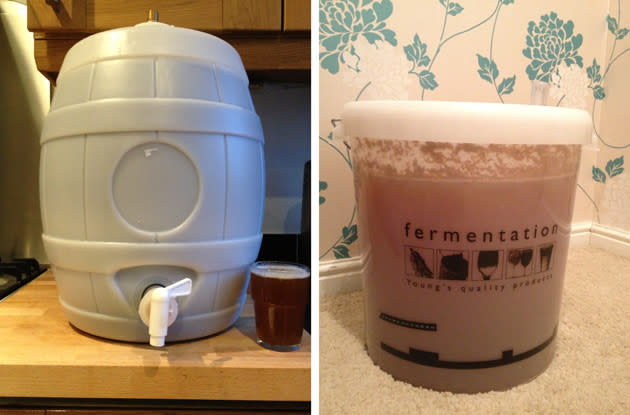How much can you save brewing your own beer?
The price of a pint goes up each year but could you save money by using a home-brew kit and brewing your own beer? And would it taste any good?

For the last few weeks my husband has been enthusiastically, if messily, brewing his own beer.
When I complained that he was filling the kitchen with kegs, hops, yeast and mountains of kit, he looked hurt. Brewing beer at home was a great way to save money, he explained. And wasn’t I always on the lookout for ways to save cash?
The answer to that is yes, but were we really going to save money? And would the result actually be drinkable?
How much did he spend getting set up?
If you know what you’re doing then you can probably get the kit for less than we paid. However, as enthusiastic amateurs, we relied on buying a handy kit.
Prices vary, but we paid £67.80 for a complete ‘microbrewery’ box that included all the ingredients we needed to brew our first barrel.
After the initial outlay on re-usable equipment, beer ingredient kits on their own cost anywhere between £15 and £25. For a real ale kit, we paid £23.28 and it will make up 40 pints.
Of course, some more experienced home brewers do without the kits and follow recipes instead, measuring their own hops and yeast, and experimenting with flavours.
Some other home brewers buy bottling kits so they can share their beer out, but we decided to stick with a barrel for now.

How difficult was it to do?
Because he used a beer kit, my husband says it was surprisingly simple to brew his own beer – it was just a case of adding the ready-measured ingredients and water.
He found a wealth of additional advice online, with forums full of people sharing their expertise and experiences. This advice was particularly useful when a pressure barrel suddenly lost containment.
That was an undeniable disaster, as freshly-brewed ale sloshed into every corner of our kitchen. But after several days of mopping it smells less like a pub – so we’ve chalked that up to experience. The internet helped us work out how to salvage the beer that was left and avoid a similar disaster in the future.
What does it taste like?
To my genuine surprise, the beer actually tastes like beer. More to the point, it tastes as good as the premium real ale that we usually buy for £1.80 a bottle at the supermarket.
Since he’s so far brewed 80-odd pints of the stuff, that’s somewhat of a relief – we’re not big drinkers and will potentially be drinking it for the next three years!
We know quite a few people who’ve brewed their own beer in the past and not enjoyed the result. So, either my husband is a micro-brewing, or the kits have improved. I’m fairly sure the kits have improved.
How much money can we save?
Brewing beer has been fun, despite the odd disaster, and it’s fun to be able to offer guests a home-brewed pint.
However, it’s not just a hobby – the websites selling the equipment all promise substantial savings. So are we saving cash?
We spend £23.28 on a kit that makes up 23 litres of good ale, so that’s just under 52p for a 500ml glass. Since we pay £1.80 at the supermarket for a 500ml bottle, that’s a saving of £1.28 a time.
At that rate, we’ll save £58.88 each time we use a beer kit to brew our own. Of course, that’s not factoring in the equipment we bought; the initial outlay was reasonably steep.
If we keep brewing our own beer then it’s easily worth it. However, if the charm wears off after these first two kegs and we never use it again then the £67.80 we spent on equipment cuts our savings quite considerably.
So it would take a little more than two barrels before you actually start making saving money overall.
But I don’t think we’re going to stop brewing. We don’t drink enough to justify brewing a barrel more than a few times a year, and that means the novelty won’t have a chance to wear off.
If you drank five 500ml glasses of homebrew a week instead of spending £1.80 on a bottle, then you’d save an impressive £332.80 a year.
Of course, if you’re not sure whether you have the patience then spending upwards of £60 on the kit is not going to be the greatest money-saving tactic.
But as long as we drink it at the same rate we drank supermarket bought beer, we’re saving money, we have a garage-full of decent beer and my husband is pretty pleased with his micro-brewing skills. For us, making our own beer has been a complete success.
Have you ever brewed your own beer? Did you do it to save money or just for fun? Share your experiences with other readers using the comments below.

 Yahoo Finance
Yahoo Finance 